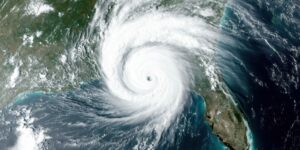Extreme weather is no longer exceptional, and that’s forcing changes at some of the world’s most diligent storm trackers: airlines.
Weather delays in the U.S. have been trending higher the past four years, upending historical patterns and jumping to an 11-year high for this year’s summer storm season, according to government data for the 30 biggest airports. In June, for example, United Airlines Holdings Inc.’s Denver hub registered as many disruptive storms as it had for the entire previous summer.
 “We’re going to anticipate that the summer weather is probably going to be a little more difficult than traditionally — that this is not going to be changing,” Delta Air Lines Inc. Chief Executive Officer Ed Bastian said in an interview. “We’ve seen a pattern here, certainly in the last couple of years.”
“We’re going to anticipate that the summer weather is probably going to be a little more difficult than traditionally — that this is not going to be changing,” Delta Air Lines Inc. Chief Executive Officer Ed Bastian said in an interview. “We’ve seen a pattern here, certainly in the last couple of years.”
Fast-moving summer storms tend to cause more last-minute disruptions because they’re hard to predict. But airlines have also noticed that those events — as well as ice and snowstorms in winter — last longer than in the past, said Jim DeYoung, United’s vice president of network operations, citing conversations at industry gatherings.
The airline industry’s experience tracks scientific consensus that global warming is affecting the vast systems responsible for nor’easters, blizzards and thunderstorms. Climate change is causing increasingly erratic behavior in the summer jet stream, which may be linked to “remarkable weather extremes” in recent years, said Michael Mann, director of the Penn State Earth System Science Center and co-author of a 2018 study on the topic.
To environmental activists, airlines aren’t just victims of climate change; they’re also perpetrators, as burning jet fuel emits greenhouse gases. But whatever the cause, carriers have been forced to address the effects, as have industries from dairy farming to auto retailing.
United has overhauled its system to re-accommodate passengers and improved how it routes planes around storms. American Airlines Group Inc. is beefing up staff to handle diverted flights. Delta is throwing out its old assumptions about how bad storms will be. In the winter, carriers cancel flights and move planes and crews to unaffected airports so service can resume quickly once a storm system has passed.
Severe weather outbreaks from last winter into this summer were “a turning point,” DeYoung said.
“Rather than the storms affecting operations for two or three hours, they seem to last all day,” he said. Chicago-based United is building tools to respond more quickly to thunderstorms that “pop up out of nowhere.”
United and other carriers are ensuring that smaller airports that receive diverted planes during storms have the staff and equipment to handle them. United also is providing crews and passengers with more specific details on how weather will affect flights.
“Our perspective is, climate change is real and we now have to prepare to deal with that reality,” DeYoung said.
Avoiding Turbulence
Beyond more frequent, longer storms, airlines also have detected more choppy air. Course and altitude changes to avoid turbulence cost U.S. carriers as much as $100 million a year and consume an additional 160 million gallons of fuel, according to a recent study by insurer Allianz SE and Embry-Riddle Aeronautical University.
Each minute of delay costs an airline $74.20, according to the trade group Airlines for America. That puts the total tally at more than $1 billion for the roughly 14 million minutes of weather-related flight delays tracked by the Federal Aviation Administration at the 30 biggest U.S. airports for the latest fiscal year.
Delta no longer can assume that delays will be relatively consistent year-to-year so is re-setting its assumptions annually based on new data. The Atlanta-based carrier also is bringing in more employees, from pilots to tarmac workers, sooner during storms to help offset shortages caused by delays, CEO Bastian said.
Delta and other airlines are also adding buffer time to their schedules for periods prone to storms so that staffing plans and passenger itineraries don’t have to get changed at the last minute.
While Southwest Airlines Co. said it hasn’t adjusted operations in response to changing weather trends, it does have new tools to deal with delays. The Dallas-based carrier recently began rolling out an automatic rebooking function for when flights are disrupted and started scanning bags at planes to better track when they are loaded on a new flight because of a cancellation.
American has begun using more airports to take diverted flights from its Dallas-Fort Worth hub — reducing its reliance on Austin, Texas — and has increased staffing to coordinate diversions. The Fort Worth-based airline also has invested in improved forecasting and is developing an app to help displaced flight crews find hotels faster, said JonCarlo Gulbranson, American’s vice president of operations and crew performance.
“It’s predominantly technology and being smarter with our current resources,” he said.
–With assistance from Eric Roston.





















 Nearmap Launches AI-Powered Portfolio Product
Nearmap Launches AI-Powered Portfolio Product  Vehicle Thefts Down 17% in 2024: NICB
Vehicle Thefts Down 17% in 2024: NICB  Half-Past Four Is the New Five O’Clock in More Efficient Workday
Half-Past Four Is the New Five O’Clock in More Efficient Workday  Berkshire, Progressive Are 2024 Underwriting Profit Leaders; Industry Income Record
Berkshire, Progressive Are 2024 Underwriting Profit Leaders; Industry Income Record 




